Callophrys rubi © photo: Trevor Chapman |
The Green Hairstreak is identified in the Thames Regional Action Plan as having Low Priority status There is no Species Action Plan available at present. Although identified as "Low Priority" the Green Hairstreak has been identified as a species whose status in Hertfordshire is uncertain and the species has shown significant recent declines. It is absent from Middlesex.
The Green Hairstreak, like most of its family, is a small butterfly whose adults fly once during the year and it is normally confined to small colonies. It is therefore a rather elusive species, often said to be difficult to see, but by hairstreak standards is quite distinctive when seen if only because it flies at a low level. The characteristic green-and-chocolate brown flickering flight is unmistakable. As it always perches with the wings closed, the green underside of the wings are visible and distinctive being of a shade of pale, slightly bluish green not often found in nature and certainly in no other British butterfly.
Individuals are usually seen in one of two possible modes. The first sightings of the season are of displaying males high in the bushes. Later sightings are usually the females flying low in search of egg laying sites usually on Rockrose but also, it has been seen to lay on Dogwood, Buckthorn, Bird's-foot trefoil, Bramble and even Cross Leaved Heath. There may be other foodplants.
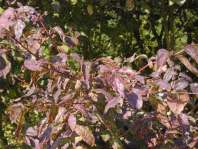 |
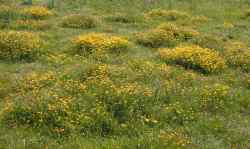 |
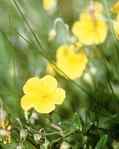 |
cornus sanguinea © photo: Malcolm Storey BioImages - Virtual Field-Guide (UK) |
lotus corniculatus © photo: Malcolm Storey BioImages - Virtual Field-Guide (UK) |
helianthemum nummularium © photo: Nigel Agar |
The caterpillars are green and inconspicuous. It is the only British hairstreak that over-winters as a pupa. Pupation seems to be dependent on ants. The pupae, which can emit a distinct squeak, have been found in ants’ nests. The first sign of the adults in late April or early May, are of displaying males, possibly accompanied by females, high in hedges or on individual bushes, perched on leaves and periodically flying up to engage in aerial dogfights with rivals. Later, the females fly low over the low herbage and chalk grassland turf in search of an egg laying site. The flight period is normally from April to June peaking in mid May. It is therefore the earliest of the British hairstreaks and the discovery of a colony can be the first butterfly treat of the year. There is the possibility that there might be a 2nd brood in July or August as fresh individuals seen flying very late have been reported from Dorset. (Reference: British Wildlife 14/1 October 2002 page 56)
The habitat must therefore contain both grassland and scrub. A restricting factor may be the existence of short well-cropped turf with well-established ant hills. Long unkempt grass can be unsuitable for ants and this breaks a chain in the habitat requirements for the hairstreaks. The catholic choice of food plant means that the Green Hairstreak can form colonies in a variety of habitats although in Hertfordshire, at present most known colonies are on the high chalk of the Chiltern ridge. One accidental result of this preference is that many Hertfordshire colonies straddle the borders with either Bedfordshire or Buckinghamshire which has the effect of distorting the records.
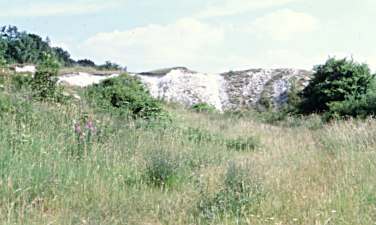 |
| Hexton Chalk Pit © photo: Nigel Agar |
Green Hairsteaks form small and discrete colonies which are sometimes scattered over a fairly wide area of a suitable habitat. They can almost certainly move through unsuitable habitat to establish new colonies. On the Telegraph/Pegsdon Hills for example a colony faithful to the lynchet area on Noon Hill failed to appear one year but a colony appeared on the other side of the Pegsdon Barns valley above a disused chalk pit. Both are on the Bedfordshire side. Sometimes the butterflies appear in the gullies on the top of Telegraph Hill and in the scrubby area known as Hoo Bit (in which case they count as Hertfordshire insects!) These locations are scattered on either side of the Beds/Herts border which can make the county records quite variable. A local extinction anywhere should not be assumed without an extensive search of nearby locations.
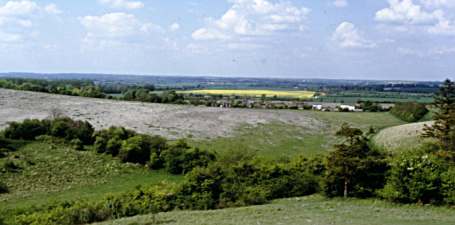 |
| Pegsdon Hills © photo: Nigel Agar |
At present, active known colonies along the Chiltern tops are the Wood Lane area near Pirton, the Pegsdon/Telegraph Hills, occasionally at Hexton Chalk Pits, the Barton Hills, Sharpenhoe Clappers, possibly the Sundon Downs then, to the west of the Luton-Dunstable conurbation, are sites along the Whipsnade escarpment, at Ivinghoe Beacon/Ashridge, Aldbury Nowers and finally Tring Park.
Off the Chilterns, there was a colony on the verge of the A41 near Hemel Hempstead but there have been no recent sightings nor at Blackmore End, near Kimpton or Crouch End between Langley and Codicote. The known sites actually within Hertfordshire are strictly therefore the Wood Lane area near Pirton, Telegraph Hill, Hexton Chalk Pits, Tring Park and Aldbury Nowers.
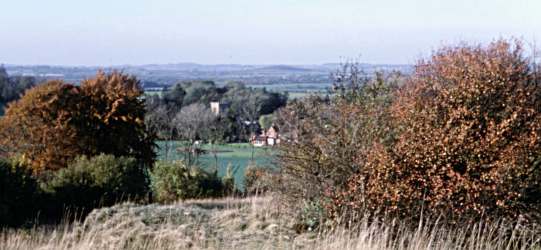 |
| Hexton © photo: Nigel Agar |
| Table 1: Sites where Green Hairstreak have been found since 2007 |
| Site | Tetrad Reference |
| Aldbury Nowers | SP9413/SP9513 |
| Tring Park | SP930105 |
| Hexton Chalk Pit | TL1029 |
| Telegraph Hill | TL1128 |
| Wood Lane/Pirton area | TL1431 |
| Table 2: Sites where Green Hairstreak have been found just outside Hertfordshire |
| Site | Tetrad Reference | County |
| Pegsdon Hills area | TL1229 | Bedfordshire |
| Sharpenhoe Clappers | TL064296 | Bedfordshire |
| Whipsnade | SP999185 | Bedfordshire |
| Barton Hills | TL095295 | Bedfordshire |
| Ivinghoe Beacon | SP961163 | Buckinghamshire |
| College Lake (Tring) | SP933140 | Buckinghamshire |
| Pitstone Hill (next to Aldbury Nowers) | SP950143 | Buckinghamshire |
| Site | Tetrad Ref. | Last seen | Site | Tetrad Ref. | Last seen |
| Aldbury Nowers | SP91L | Still present | Datchworth | TL21U | 1971 |
| Hudnall Common* | TL01B | 1936 | Bramfield Wood/Forest | TL21Y | |
| Bricket Wood | TL10F | 1907 | Knebworth Woods | TL22G | 1922 |
| Symondshyde | TL11V | 1951 | Graveley | TL22I | 1948 |
| Wheathampstead | TL11W | 1986 | Little Woods | TL22X | 1941 |
| Lamer Park | TL11Y | 1979 | Weston Hills | TL23L | 1979 |
| Ravensburgh Castle | TL02Z | 1985 | Weston | TL23Q | 1986 |
| Noon Hill | TL12E | Present | Cuffley Station | TL30A | 1972 |
| Telegraph Hill | TL12J | Still present | Fanshaws | TL30J | 1955 |
| Deacon Hill | TL12J | Still present | Danemead | TL30N | 1977 |
| Hexton Chalk Pits | TL13A | Still present | Bayfordbury | TL31A | 1970 & 1974 |
| Pirton | TL13F | Still present | Brights Hill | TL32B | 1986 |
| Tingley Wood | TL13F | N/A | St. Johns Wood | TL32C | 1945 |
| Wood Lane area, Pirton | TL13F | Still present | Green Tye | TL41P | 1976 |
| Dell, Cuffley* | TL20F | 1965 | Stocking Plantation | TL42K | 1942 |
| Essendon | TL20T | 1938 | Long Meadow | TL42Q | 1942 |
| Lemsford Springs | TL21G | 1979 | Whippendell Woods | TQ09T | 1979 |
| Digswell | TL21H | 1961 | Oxhey Woods | TQ19B | 1907 |
| Mardley Heath | TL21N | 1986 |
Click on map for details
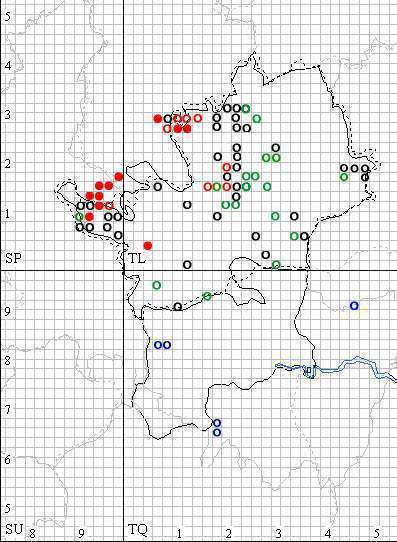
| SYMBOL | DATE | REFERENCE SOURCE |
 | 2002-2004 | Indicates records sent to Nigel Agar and/or reported to the HMBC Branch Website for the year 2002-2004 |
| O | 1995-2001 | Indicates records taken from the Herts & Middx Butterfly Report for 1999 - John B. Murray & Rob Souter and Herts & Middx Butterfly Report for 2001 - John B. Murray & Andrew Wood |
| O | 1970-1987 | Indicates records taken from Butterflies of Hertfordshire - Brian Sawford 1987 |
| O | 1980-1986 | Indicates records taken from Butterflies of the London Area - Colin Plant 1987 |
| O | prior to 1970 | Indicates records taken from Butterflies of Hertfordshire - Brian Sawford 1987 |